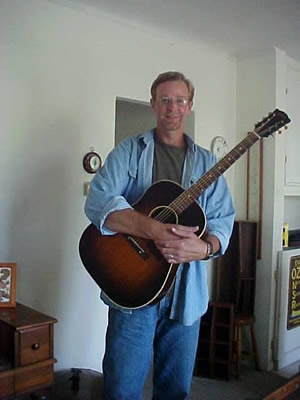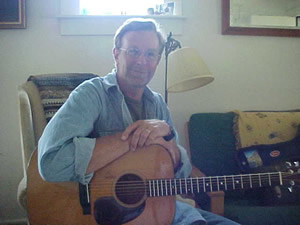 |
|
|
| Age: |
49 |
| |
|
| Hometown: |
Kirkwood,
MO |
| |
|
| Profession/Type of
Art: |
music: guitar, banjo,
fiddle, mandolin, pedal steel guitar, dobro |
| |
|
| Musical Styles: |
bluegrass,
folk, Americana |
John Higgins
and his family moved to Kirkwood when he was two years old. He has
lived briefly in a couple of other places, but most of
his life, Higgins has been in the Kirkwood area. He attended St. Peter's
Grade School and Kirkwood High School. He was also a student at St.
Louis Community College at Meramec and University of Missouri-St.
Louis.
When attending
St. Peter's, Higgins had the opportunity to take music lessons. He
signed up for guitar instruction at the age of eight. The
teacher not only taught Higgins method, but also how music fit together,
how it worked. His parents also were both musical, playing piano
and singing.
Higgins still uses the first guitar he bought with lawn mowing and
raking money. He purchased the Martin with advice from Mel Bay.
Over the years,
Higgins has worked as a musician, but he also worked in a music store
for awhile and did some instrument repair. He then
did repairs for a large importer. After that, he spent twelve years
in repair and restoration of guitars for a company that included warranty
work.
After a couple of years with a multimedia company, Higgins decided
to strike out on his own in the musical instrument repair and restoration
business. Higgins built his first guitar when he was eighteen. He produces
about two a year.
Higgins has a wife, Kally, a daughter who is sixteen and three stepchildren,
two girls and a boy ages fourteen, twelve, and ten.
The following interview with John Higgins was conducted by Cheryl
Blake, UM-St. Louis, September 2004.
Q. What kinds of things are you currently doing with your music?
A.
This is my fifth season to perform Folk Music in the Melting Pot
at the Sheldon. It is a production that presents the history of folk
music in America in about an hour. It is geared to elementary school
children, but the performances are open to the public. You could walk
up and purchase a ticket. I will be doing ten performances of the show
this school year. I co-wrote the show with three other people, and
it is produced by the Sheldon.
The
school children sometimes come to the theater and think it's
at least a day away from school. They see us and our instruments,
how old we are, and they don't show any interest. We start
with the Revolutionary War period of folk music and go up
to Bob Dylan. I show how the music has influenced the blues,
rock and roll, and rap. Then we have a question and answer
session, and they actually have questions. We've caught their
interest.
This
year I will also do four shows of the Music of Lewis and
Clark. We know there were two fiddlers on the expedition.
So we tell the story of the expedition through them and the
music. It's cool to get the kids to see music actually generated
with just voice and instruments, instead of what they are
used to on MTV for instance.
I
also work with Young Audiences of St. Louis. They
have chapters across the United States with
rosters of artists. I work with two other
people, and
we do three productions. There is a folk music primer. We also
perform That Itchin' Heel about migration in
the U.S., and that's very American.
|
|
And
we do a multimedia show called Bingham's America. That includes
narration and music and over 200 slides, and is very historically
specific. Again, these are for the elementary schools, but we
go to them. All of this is the educational part of my work.
Q. How did
you get into the educational area?
A.
The Young Audiences Folk Trio has been in existence for twenty
years. A friend from another group I play with is in the trio and
someone left. He asked me to join. And the work at the Sheldon
came about because they wanted to do some educational outreach.
They contacted me and gave me some people to work with, and we
started writing.
This kind of performance is not for everybody. You never want to talk
down to the kids. You want to engage them without being artificial.
When you play at a club, adults come expecting music. You're part of
a package. It's a different thing with kids, a real challenge. It puts
you in touch with your art like nothing else would. It has made me
go back to the base level of why I do what I do. If you have been a
professional for thirty years, you can lose sight of that.
With
the kids, I have to make myself accessible but hold their attention
too. We can't get too silly. We are there not just to entertain, but
also to expose the kids to the history and the art. As an artist, I
make a connection with adults, and that is valuable. With kids, it's
raw energy.
Q. Besides the educational performances, what do you do with your
music?
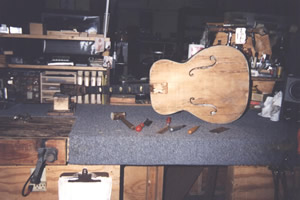
before restoration, front and back
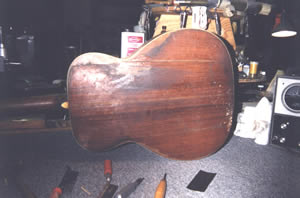 |
A.
I have been performing professionally for thirty years.
When I was in my twenties, I traveled, mostly in the western
U.S. I was immersed in the music, so I grew as an artist.
That kind of life can be a turn off for
some people. It depends on how your music lives inside
of you. By the age of twenty-five, I knew I didn't
want to travel all of the time, so I returned to St. Louis,
went back to school, and worked in a music
store. I did instrument repair, which I continued to do
when I went to work for a large importer. Then I worked
for a company for twelve years where I repaired and restored
guitars. I still played and did recording sessions.
I
have done some engineering and producing, and I have a studio.
I went to work for a multimedia company but after a couple
of years, I had to make a decision. It wasn't growing the
way we had anticipated. All along I had been building guitars.
People had been calling for me to repair instruments as well.
So I took the plunge and jumped into the repair and restoration
full time.
I
do the repair work for stores and vintage dealers. I don't
do much smaller work any more. And I still build about
two guitars a year. The repairs and
restoration fill my days, and I |
still
play sessions,
and I am in a group: the Flying
Mules. We play bluegrass, folk, Americana--all acoustic.
We perform 50 or 60 times a year. So including all of the
music I play, I perform about 100 shows in a year. I feel
fortunate because there are a lot of good musicians and
not that much work just in St. Louis.
Q. How did you
get into building guitars?
A. I built
my first guitar when I was eighteen. It's always been
an interest. A few years ago, a professor from Southern
Illinois University at Edwardsville asked me to build
a specialized seven string guitar. It's
a South American style, and the
|
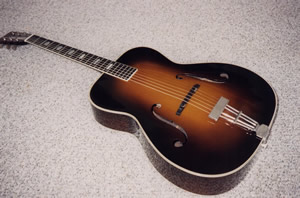 after restoration
after restoration
|
strings
are all nylon. Jazz musician, John Pizarelli, has
bought them from me as well.
Q. What
about making your art your livelihood?
A.
I was looking back to when I was eighteen and there was no
way I could have anticipated all of the twists and turns
in thirty years.
To
make a living at music, you have to have a good head for
scheduling. You must look at time realistically. People have
to be able to count on you. There's the pure artist who lives
by his art or craft, and there's the person who is really
concerned with business, and there's all variations in between.
When
I get up, I know that whatever I do that day, it's somehow
involved with music. It's twenty-four/seven/three hundred
sixty-five.
So it helps to have a partner who understands. And it also
helps to have some interest that is totally different to
relieve stress. I fish, float Missouri streams, camp and
hike. You need a physical and emotional outlet. |
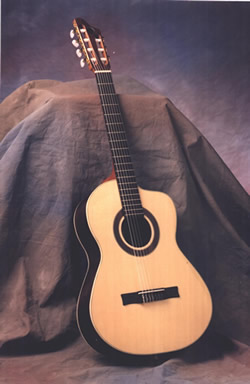 Higgins'
design
Higgins'
design
|

